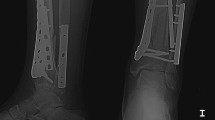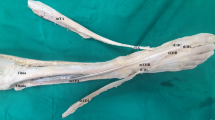Abstract
The main muscles responsible for extension of the toes are the extensor digitorum longus and extensor hallucis longus. Morphological variants of both of these muscles are mostly related to the numbers of tendons and their unusual points of insertion. The case presented shows an accessory band deriving from the extensor digitorum longus and fusing with the extensor hallucis longus, a concomitant additional tendon of the latter inserting to the proximal phalanx of the hallux. Knowledge of these anatomical patterns is important not only from the anatomical but also the clinical point of view and can be useful in lower limb surgery.

Similar content being viewed by others
Availability of data and materials
Please contact authors for data requests (Łukasz Olewnik, Ph.D.—email address: lukasz.olewnik@umed.lodz.pl).
References
Banerje A, Singh S, Raza K, Rani N, Kaler S (2016) Unilateral variation in extensor digitorum longus muscle. Clin Ter 167:150–151. https://doi.org/10.7417/CT.2016.1946
Boyd N, Brock H, Meier A, Miller R, Mlady G, Firoozbakhsh K (2006) Extensor hallucis capsularis: frequency and identification on MRI. Foot Ankle Int 27:181–184. https://doi.org/10.1177/107110070602700305
Egea JM, Cabeza L, Ortiz R, Rama AR, Melguizo C, Prados J (2019) Double origin of the extensor hallucis longus muscle: a case report. Surg Radiol Anat 41:1421–1423. https://doi.org/10.1007/s00276-019-02309-5
Elgafy H, Ebraheim NA, Shaheen PE, Yeasting RA (2002) Extensor hallucis longus innervation: an anatomic study. Clin Orthop Relat Res 398:245–251. https://doi.org/10.1097/00003086-200205000-00034
Gruber W (1875) Über die varietäten des musculus extensor hallucis longus. Arch Anat Physiol Wissen Med 1875:565–589
Hill RV, Gerges L (2008) Unusual accessory tendon connecting the hallucal extensors. Anat Sci Int 83:298–300. https://doi.org/10.1111/j.1447-073X.2008.00229.x
Karauda P, Shane Tubbs R, Polguj M, Olewnik Ł (2021) Morphological variability of the extensor hallucis longus in human fetuses. Ann Anat 234:151627. https://doi.org/10.1016/j.aanat.2020.151627
Kelikian AS, Sarrafian SK (2011) Sarrafian’s anatomy of the foot and ankle: descriptive, topographic, functional. Lippincott Williams & Wilkins, Philadelphia
Lai K-C, Tan H-W, Chen L-J, Liu P-H, Tseng G-F, Ho H-C (2021) Characteristics of the accessory tendon of the extensor hallucis longus muscle: a Taiwanese study. Surg Radiol Anat 43:1053–1059. https://doi.org/10.1007/s00276-020-02648-8
Natsis K, Konstantinidis GA, Symeonidis PD, Totlis T, Anastasopoulos N, Stavrou P (2017) The accessory tendon of extensor hallucis longus muscle and its correlation to hallux valgus deformity: a cadaveric study. Surg Radiol Anat 39:1343–1347. https://doi.org/10.1007/s00276-017-1881-4
Olewnik Ł (2019) Fibularis tertius: anatomical study and review of the literature. Clin Anat 32:1082–1093. https://doi.org/10.1002/ca.23449
Olewnik Ł, Podgórski M, Polguj M, Ruzik K, Topol M (2019) A cadaveric study of the morphology of the extensor hallucis longus—a proposal for a new classification. BMC Musculoskelet Disord 20:1–2. https://doi.org/10.1186/s12891-019-2688-8
Park J-H, Choi Y-J, Park K-R, Kim D, Kwon H-W, Lee M, Cho J (2021) Independent muscle of extensor hallucis capsularis: a cadaveric case report. Surg Radiol Anat 43:1041–1044. https://doi.org/10.1007/s00276-020-02592-7
Ruzik K, Westrych K, Tubbs RS, Olewnik Ł, Łabętowicz P, Zielinska N (2022) Case report of the double headed extensor hallucis longus. Folia Morphol (Warsz). https://doi.org/10.5603/FM.a2022.0018
Sakuma E, Kato H, Honda N, Mabuchi Y, Soji T (2004) A rare anomaly of the extensor digitorum longus. Anat Sci Int 79:235–238. https://doi.org/10.1111/j.1447-073x.2004.00082.x
Standring S (2021) Gray’s anatomy: the anatomical basis of clinical practice. Elsevier Health Sciences, New York
Testut L (1884) Les Anomalies musculaires chez l’homme expliquées par anatomie comparée, importance en anthropologie. Masson, Paris
Tezer M, Cicekcibasi AE (2012) A variation of the extensor hallucis longus muscle (accessory extensor digiti secundus muscle). Anat Sci Int 87:111–114. https://doi.org/10.1007/s12565-011-0108-8
Tubbs RS, Shoja MM, Loukas M (2016) Bergman’s comprehensive encyclopedia of human anatomic variation. Wiley, Hoboken
Zdilla MJ, Paulet JE, Lear JJ, Addie KM, Lambert HW (2018) A review of extensor hallucis longus variants featuring a novel extensor primi internodii hallucis muscle merging with extensor hallucis brevis. J Foot Ankle Surg 57:1218–1220. https://doi.org/10.1053/j.jfas.2018.03.031
Zielinska N, Tubbs RS, Ruzik K, Olewnik Ł (2021) Classifications of the extensor hallucis longus tendon variations: updated and comprehensive narrative review. Ann Anat Anat Anz 238:151762. https://doi.org/10.1016/j.aanat.2021.151762
Acknowledgements
The authors sincerely thank those who donated their bodies to science so that anatomical research could be performed.
Funding
The authors have no financial or personal relationship with any third party whose interests could be influenced positively or negatively by the article’s content. This research received no specific grant from funding agencies in the public, commercial, or not-for-profit sectors.
Author information
Authors and Affiliations
Contributions
AW (student)—project development, data collection, data analysis, manuscript writing. NZ (student)—photo, data analysis, manuscript editing. RST (MD, Ph.D.)—data analysis and manuscript editing. JI (MD, Ph.D.)—professor—data analysis and manuscript editing. ŁO (D.P.T, Ph.D.)—associate professor—photo, data analysis, manuscript editing.
Corresponding author
Ethics declarations
Competing interests
The authors declare no competing interests.
Conflict of interest
The authors declare that they have no competing interests.
Ethical approval and consent to participate
The study protocol was accepted by the Bioethics Committee of the Medical University of Lodz. The cadavers were the property of the Department of Anatomical Dissection and Donation, Medical University of Lodz. Informed consents were obtained from all participants before they died.
Consent to publish
Not applicable.
Additional information
Publisher's Note
Springer Nature remains neutral with regard to jurisdictional claims in published maps and institutional affiliations.
Rights and permissions
About this article
Cite this article
Węgiel, A., Zielinska, N., Tubbs, R.S. et al. Coexistence of accessory band with the second type of extensor hallucis longus. Surg Radiol Anat 44, 845–849 (2022). https://doi.org/10.1007/s00276-022-02966-z
Received:
Accepted:
Published:
Issue Date:
DOI: https://doi.org/10.1007/s00276-022-02966-z




